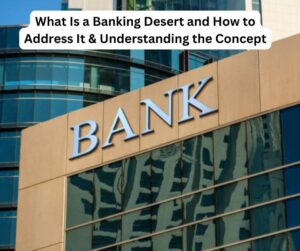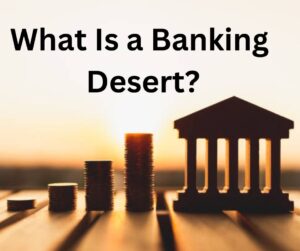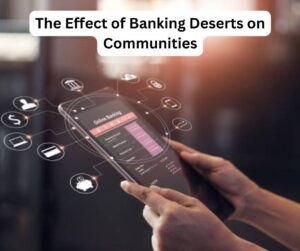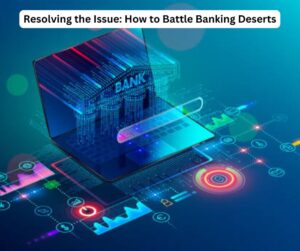
What Is a Banking Desert and How to Address It & Understanding the Concept
In numerous metropolitan and country regions across the world, admittance to monetary administrations is something individuals underestimate.
In any case, for millions, living in a banking desert implies being cut off from conventional financial administrations, for example, investment accounts, credits, and monetary direction.
The term banking desert alludes to regions where there are no bank offices inside a sensible distance, making it hard for occupants to get to banking administrations.
What Is a Banking Desert?

A banking desert is a region where bank offices and monetary foundations are inadequate or non-existent, passing on inhabitants without simple admittance to fundamental financial administrations.
Regularly, these regions are characterized by having no bank or credit association branch inside a 10-mile range, albeit in thickly populated metropolitan regions, the distance might be more limited.
Banking deserts are regularly tracked down in provincial regions, yet they can likewise exist in specific metropolitan neighborhoods where banks have shut down branches because of low productivity.
In financial deserts, occupants frequently need admittance to administrations like reserve funds and financial records, individual advances, and credit administrations.
The Effect of Banking Deserts on Communities

The shortfall of conventional financial administrations can have extensive ramifications for people and networks:
– Restricted Monetary Inclusion:
Individuals living in financial deserts are frequently unfit to open bank accounts or access reasonable advances.
Without these administrations, it is challenging for people to construct credit, save for crises, or plan for what’s to come.
– Reliance on Significant expense Alternatives:
without a trace of customary banks, inhabitants might go to payday moneylenders and check-changing out administrations.
These administrations frequently charge high expenses and loan fees, making it challenging for individuals to break out of patterns of obligation.
Ongoing Model: A Financial Desert in Country America

One continuous illustration of a financial desert can be found in the rustic districts of the Mississippi Delta, a locale in the US known for its monetary difficulties and neediness rates.
Numerous towns in this space have seen their bank offices close throughout the long term, passing on occupants without simple admittance to conventional monetary administrations.
Subsequently, individuals in these networks frequently need to travel significant distances — once in a while 30 miles or more — to come to the closest bank.
For inhabitants without solid transportation, getting to these administrations turns out to be exceedingly difficult.
Subsequently, many go to check-changing out administrations and payday advances, which charge high expenses, lessening how much cash they can spend on fundamentals like food, lodging, and medical services.
Resolving the Issue: How to Battle Banking Deserts

Resolving the issue of banking deserts requires a diverse methodology that includes monetary establishments, government strategies, and local area commitment.
Here are a few expected methodologies:
1. Encouraging People group Banks and Credit Unions:
One method for addressing banking deserts is to energize the foundation of local area banks and credit associations in underserved regions.
These more modest organizations frequently have a more profound comprehension of nearby requirements and can offer customized types of assistance.
They are bound to loan to nearby organizations and people, which can assist with animating monetary action around there.
2. Mobile and Advanced Banking Solutions:
Growing admittance to versatile and computerized banking can overcome any barrier among inhabitants and banking administrations.
For instance, offering monetary education programs that show inhabitants how to utilize computerized financial devices can enable them to deal with their cash without requiring an actual branch.
Notwithstanding, it’s vital to guarantee that networks approach dependable web and versatile administrations for this way to deal with be successful.
3. Government Motivations for Bank Expansion:
Neighborhood and national state run administrations can give motivators to banks to open branches in underserved regions.
This could incorporate tax reductions, allows, or financed advances for banks ready to set up branches in financial deserts.
Government-supported projects can likewise zero in on offering minimal expense advances to neighborhood organizations through local area improvement monetary foundations (CDFIs).
4. Banking Associations with Retailers:
Banks can join forces with retailers like general stores or corner shops to offer financial administrations through in-store kiosks* or ATM.
This model permits banks to decrease the above expenses of keeping a full branch while as yet giving essential financial administrations.
For instance, a supermarket in a country town could have an ATM or a financial booth, giving occupants admittance to cash withdrawals, stores, and record the board.
5. Fintech Solutions:
Fintech organizations can possibly change banking deserts by offering on the web just financial choices.
These administrations can give admittance to investment accounts, credits, and other financial items without the requirement for actual branches.
Notwithstanding, for fintech answers for be powerful, endeavors should be made to guarantee advanced proficiency and admittance to internet providers in underserved regions.
Continuous Model: Tending to Banking Deserts with Fintech
Lately, the city of Detroit, Michigan, has confronted the test of banking deserts, especially in low-pay areas.
Perceiving this, neighborhood local area associations and fintech organizations cooperated to give elective financial arrangements.
One such drive included portable financial vans furnished with ATMs and staff who could help with computerized financial enlistment.
This portable methodology brought financial administrations straightforwardly to the areas that required them most, lessening the movement trouble on inhabitants and expanding monetary proficiency.
